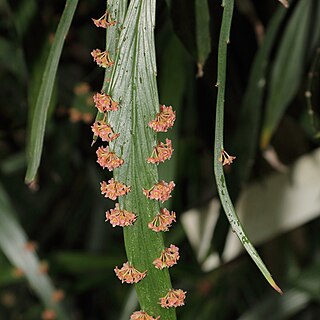
Asparagus, or garden asparagus, folk name sparrow grass, scientific name Asparagus officinalis, is a perennial flowering plant species in the genus Asparagus. Its young shoots are used as a spring vegetable.

Methanethiol is an organosulfur compound with the chemical formula CH
3SH. It is a colorless gas with a distinctive putrid smell. It is a natural substance found in the blood, brain and feces of animals, as well as in plant tissues. It also occurs naturally in certain foods, such as some nuts and cheese. It is one of the chemical compounds responsible for bad breath and the smell of flatus. Methanethiol is the simplest thiol and is sometimes abbreviated as MeSH. It is very flammable.

Asparagus is a genus of flowering plants in the family Asparagaceae, subfamily Asparagoideae. It comprises up to 300 species. Most are evergreen long-lived perennial plants growing from the understory as lianas, bushes or climbing plants. The best-known species is the edible Asparagus officinalis, commonly referred to as just asparagus. Some other members of the genus, such as Asparagus densiflorus, are grown as ornamental plants.

Ornithogalum pyrenaicum, also called Prussian asparagus, wild asparagus, Bath asparagus, Pyrenees star of Bethlehem, or spiked star of Bethlehem, is a plant whose young flower shoots may be eaten as a vegetable, similar to asparagus.

Asparagaceae, known as the asparagus family, is a family of flowering plants, placed in the order Asparagales of the monocots. The family name is based on the edible, garden asparagus, Asparagus officinalis. Those who live in the temperate climates may be surprised to learn that this family includes both common garden plants as well as common houseplants. The garden plants, include: asparagus, yucca, bluebell, and hosta. And the houseplants, include: snake plant, corn cane, spider plant and plumosus fern.

Carl Friedrich von Ledebour was a German-Estonian botanist.

Asparagus racemosus is a species of asparagus common throughout India and the Himalayas. and northern Australia. It grows 1–2 m tall and prefers to take root in gravelly, rocky soils high up in piedmont plains, at 1,300–1,400 m (4,300–4,600 ft) elevation. It was botanically described in 1799. Because of its multiple uses, the demand for Asparagus racemosus is constantly on the rise. Due to destructive harvesting, combined with habitat destruction, and deforestation, the plant is now considered "endangered" in its natural habitat.

Asparagus setaceus, commonly known as common asparagus fern, asparagus grass, lace fern, climbing asparagus, or ferny asparagus, is a climbing plant in the genus Asparagus. Despite its common name, the plant is not a true fern, but has leaves that resemble one.

Asparagus asparagoides, commonly known as bridal creeper, bridal-veil creeper, gnarboola, smilax or smilax asparagus, is a herbaceous climbing plant of the family Asparagaceae native to eastern and southern Africa. Sometimes grown as an ornamental plant, it has become a serious environmental weed in Australia and New Zealand.

Asparagus aethiopicus, Sprenger's asparagus, is a plant native to the Cape Provinces and the Northern Provinces of South Africa. Often used as an ornamental plant, it is considered an invasive weed in many locations. Asparagus fern, asparagus grass and foxtail fern are common names; however, it is unrelated to true ferns. A. aethiopicus has been confused with A. densiflorus, now regarded as a separate species, so that information about A. aethiopicus will often be found under the name A. densiflorus.

Phylloclades and cladodes are flattened, photosynthetic shoots, which are usually considered to be modified branches. The two terms are used either differently or interchangeably by different authors. Phyllocladus, a genus of conifer, is named after these structures. Phylloclades/cladodes have been identified in fossils dating from as early as the Permian.
Asparagus virus 1 (AV-1) is one of the nine known viruses that affects asparagus plants. It is in the Potyviridae family. Initially reported by G. L Hein in 1960, it is a member of the genus Potyvirus and causes no distinct symptoms in asparagus plants. The only known plant that can get AV-1 is asparagus plants. It is spread by aphids vectors, which means that aphids do not cause the AV-1, but they do spread it.

Asparagoideae is a subfamily of monocot flowering plants in the family Asparagaceae, order Asparagales, according to the APG III system of 2009. The subfamily name is derived from the generic name of the type genus, Asparagus. The group has previously been treated as a separate family Asparagaceae sensu stricto.

Asparagus virgatus is a species of flowering plant in the Asparagaceae family. It indigenous to South Eastern Africa. It is also known as tree fern, tiki fern, and African broom fern. Asparagus virgatus is a member of the genus Asparagus, and not a true fern.

Asparagus densiflorus, the asparagus fern, plume asparagus or foxtail fern, is a variable evergreen perennial plant, closely related to the vegetable asparagus.

Medeola virginiana, known as Indian cucumber or Indian cucumber-root, is an eastern North American plant species in the lily family, Liliaceae. It is the only currently recognized plant species in the genus Medeola. It grows in the understory of forests. The plant bears edible rhizomes that have a mild cucumber-like flavor.
Asparagus litoralis, common name coastal asparagus, is an evergreen perennial plant species belonging to the genus Asparagus in the monocot family Asparagaceae, according to some sources, including the Black Sea Red Data Book. Other sources do not recognize this species, placing the four synonyms recognized by the Black Sea Red Data Book into two different species:

Asparagus aphyllus is a species of plants in the family Asparagaceae. They are climbing plants. Flowers are visited by the Western honey bee, Syritta pipiens, Phthiria, and Halictus.

Asparagus horridus is a species of shrub in the family Asparagaceae. They are climbing plants. They have simple, broad leaves and fleshy fruit. Individuals can grow to 1 m (3.3 ft) tall.















